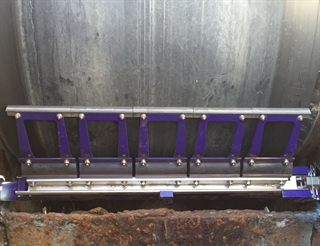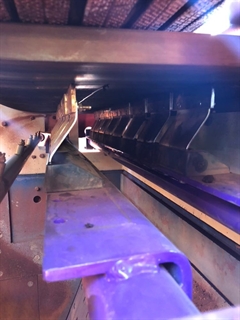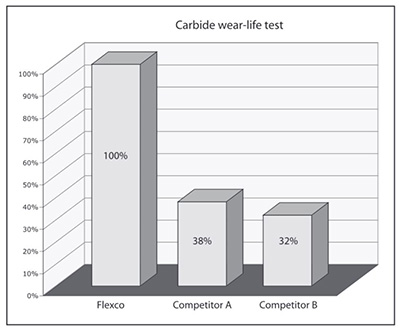The No Nonsense Guide to Why Tungsten Carbide Blades Are Used On Belt Cleaners
 Why are tungsten carbide blades used on belt cleaners? That’s easy. Tungsten carbide tipped blades provide superior cleaning efficiency. Is this the shortest blog post ever? No! Keep reading because there is a lot more to it. I’m going to break down the differences between carbides, why you should choose a carbide blade, and where you should use a carbide blade. Why do you ask? Because carbide tipped belt cleaners are an extremely popular choice in the market and we get a lot of questions about their proper use.
Why are tungsten carbide blades used on belt cleaners? That’s easy. Tungsten carbide tipped blades provide superior cleaning efficiency. Is this the shortest blog post ever? No! Keep reading because there is a lot more to it. I’m going to break down the differences between carbides, why you should choose a carbide blade, and where you should use a carbide blade. Why do you ask? Because carbide tipped belt cleaners are an extremely popular choice in the market and we get a lot of questions about their proper use.
Carbide blades feature a lower lifetime cost–due to their durability–compared to many other blade types. Traditionally, tungsten carbide blades were only compatible with vulcanized belts. Today, technical advancements with certain blade options make these blades more compatible with mechanically-spliced belts as well.
Are all tungsten carbide blades the same?
Absolutely not! Carbide is a composite of carbide granules and binder metals that provides a very hard, long-wearing material for belt cleaner blades. There are several ways to vary the mixture. Some low-cost carbides can also have inferior wear resistance which results in short blade life, which means more downtime spent maintaining the cleaners and changing out the tips.
Others have poor impact resistance and can chip out— another way to cause potential damage to the belt. Also, many blade tips are weakened with voids or binder pooling due to inferior production processes. Ultimately, bargain-priced carbide isn’t always a bargain, and high-grade carbide blades really are worth the investment.
What should you look for in a tungsten carbide blade?
When choosing a tungsten carbide blade, I recommend looking for blades that offer three things:
- Better cleaning efficiency. When optimally tensioned, the thin, hard blade will provide superior cleaning performance. Again, make sure you aren’t sacrificing performance or putting your belt at risk with poor quality carbides. Here’s a real-life result detailing how a copper/gold site was suffering from short blade life and carryback. They switched to an MHS Heavy-Duty Secondary Cleaner and U-Type Secondary Cleaner with carbide blades which resulted in less carryback and longer blade life.
- Good value. When you consider lifetime cost vs. initial cost, a tungsten carbide blade’s durability and lower required maintenance often make up the cost difference over the life of the blade. This becomes important when you think about your bottom line and cost of downtime.
- Versatility. With the advancement in technology, you shouldn’t have to worry about if the carbide tips can or can’t be used with mechanical fasteners. Make sure the carbide tips you choose give you the versatility to handle both possibilities.
 Where to use tungsten carbide blades
Where to use tungsten carbide blades
Tungsten carbide blades can be used in many different applications and industries. If you are considering whether carbide is the right option for you, think about using tungsten carbide blades in the following situations:
- When you need unbeatable performance. Highest cleaning efficiency is a key attribute that makes tungsten carbide the right choice in applications where unbeatable performance is required. They can stand up to the toughest applications.
- When using with highly abrasive materials. Tungsten carbide blades are extremely wear-resistant making them an excellent choice when you are conveying highly abrasive materials on your belt line.
- When you want to reduce maintenance. This is a common reason why many users choose carbide-tipped blades; they’re well worth the investment in applications where less durable blade materials result in unacceptable wear rates, cause frequent retensioning tasks, and increase maintenance costs.
 High-grade carbide blades are worth the investment.
High-grade carbide blades are worth the investment.
Tungsten carbide blades from Flexco are made from a superior grade of carbide – free from contamination, binder pooling, voids, and coarse structure that often occur in inferior products. This superior composite makes our carbide blades long lasting and impact resistant. Flexco has done extensive research and invested in years of testing to design and manufacture the right tungsten carbide blades for demanding applications. A carefully selected standardized ASTM Abrasion Test (results are shown at right) shows carbide from Flexco lasts approximately three times longer in belt cleaning conditions.
Cleaning your belts properly will extend their life and productivity
Tungsten carbide blades can be the most cost-effective means to provide superior cleaning power with vulcanized or mechanically-spliced belts. But the type of blade/tip you choose can make a great deal of difference. There are different tungsten carbide blades on the market and it’s tough to determine which ones are quality products. You can’t tell by the naked eye. But we can help you.
Flexco tungsten carbide blades:
- Offer a superior level of cleaning efficiency that only a top-quality tungsten carbide can provide.
- Are compatible with Flexco and other mechanical belt splices.
- Provide long life even in longwall mining or high-tonnage aggregate and iron ore applications.
- When correctly specified and installed, will not cause excess belt wear and will outlast urethane by up to 10 times.
Flexco offers two types of tungsten carbide blades:
C-Tip — a specially-designed blade with impact-resistant tungsten carbide that offers the cleaning efficiency of a metal blade and is compatible with Flexco splices. For sites that have a mix of vulcanized or mechanical splices or may use rip repair mechanicals on a vulcanized belt, C-Tips provide the versatility to work in all applications.
V-Tip — an exclusive tungsten carbide provides extra-long wear life that is typically measured in years instead of months. V-Tips are for use with vulcanized belts only.
Authored by: Kevin Fales, Product Manager
Fales manages the belt conveyor product (BCP) line, providing product development and engineering with guidance on market requirements for both new product concepts and existing products. He also leads the development of technical and promotional literature supporting BCP line. Fales graduated from Grand Valley State University with a bachelor’s degree in Marketing and is currently working toward his master’s degree in business administration from Western Michigan University.
Subscribe to the Flexco Blog
Related Blogs
Published Date
November 05, 2018Product Group
- Belt Cleaning Systems
Issues
- Belt Wear
- Blade Life
- Carryback
- Downtime